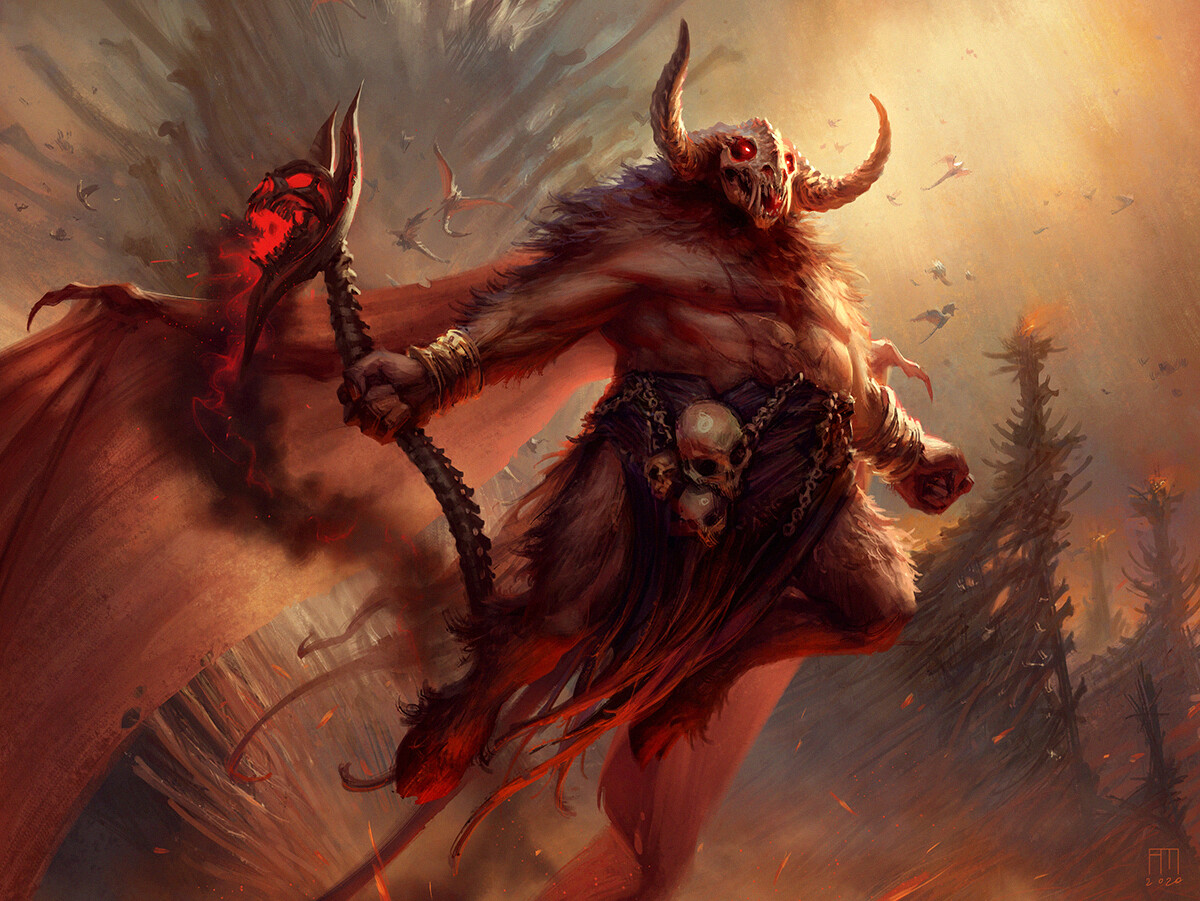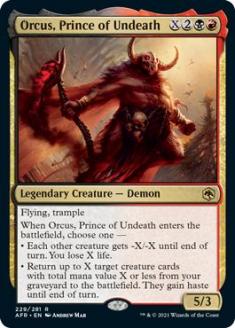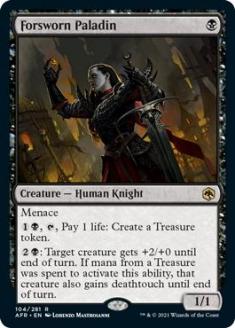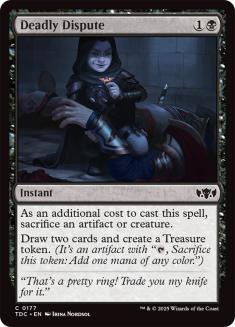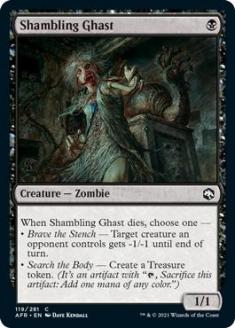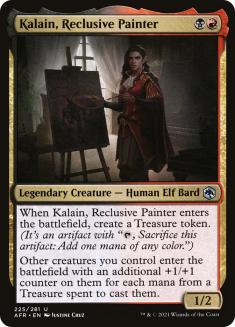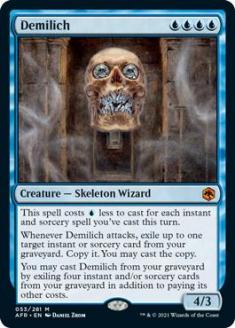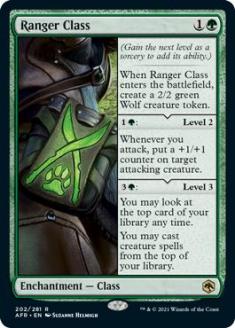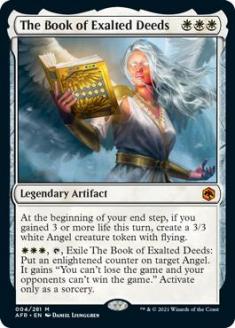I was wrong.
These are probably my three favorite words I can use when I’m starting an article. They signify so many things. I’ve learned something. I’ve gained a better understanding of a game I’ve played for 25 years. I’ve got something I’m excited to share with you. Magic has surprised me yet again, validating the massive amount of time I’ve invested in it.
If I weren’t routinely getting things wrong about Magic, I would have lost interest a long time ago. And so, I’m happy to be able to report that I was way off base with my initial impressions of D&D: Adventures in the Forgotten Realms. I’m not claiming it’s an all-timer or anything, but my last four days with the set has convinced me that it’ll be a positive addition to an extremely powerful Standard. I don’t know if any of these decks that I’ve been working on are about to crack the top tier and redefine the metagame, but they’re all competitive, and some are dramatic changes of pace from the way we’ve been playing the game for the last couple of years. Let’s look at some of the cards and strategies that have stood out to me thus far.
1. Orcus, Prince of Undeath
I believe Orcus, Prince of Undeath is the best card in Adventures in the Forgotten Realms, primarily for how it interacts with the best mechanic in the format, Adventure. The various flavors of Adventure decks all make their living by going wide and generating more value than non-Adventure decks could ever dream of. Orcus challenges all points of the Adventures gameplan.
It controls the small bodies like Edgewall Innkeeper or Toski, Bearer of Secrets that are generating the obscene amounts of card advantage. It can level the playing field after Adventures decks have successfully gone wide. It even can generate some of the same type of battlefield explosions that have been the sole domain of Adventures decks since they first arrived in Standard.
So what’s the best possible home to take advantage of all of these angles?
Sigh… It’s Jund Adventures.
Creatures (32)
- 3 Order of Midnight
- 4 Lovestruck Beast
- 4 Edgewall Innkeeper
- 4 Bonecrusher Giant
- 4 Rimrock Knight
- 1 Tangled Florahedron
- 4 Kazandu Mammoth
- 4 Jaspera Sentinel
- 4 Orcus, Prince of Undeath
Lands (24)
Spells (4)

This take on the archetype is leaning back towards the speed we used to see from Gruul Adventures, which is a necessary move when you forfeit the disruption that white brings to the table with Elite Spellbinder. The good news is that the 5/3 flampling body of Orcus is just as willing to play the aggressive games. I cast a lot of four-mana Orcuses. However, if you do have to go long, you’ll have the tools to do that as well.
Orcus virtually guarantees you will always win the Edgewall Innkeeper war, since you’re easily wiping out your opponents and able to bring back your own. Order of Midnight makes this trick repeatable, and now you have the capability to grind with anyone in the format.
This deck is utterly terrifying. If the clock combined with a little bit of sideboard disruption is enough to hold down Emergent Ultimatum decks, we might have a new best flavor of Adventures on our hands.
Of course, if I were just tweaking an already great deck, I’d be a little more reserved in my appreciation for Orcus. I think it’s got the capability to create new archetypes as well.
Creatures (27)
- 2 Gadrak, the Crown-Scourge
- 4 Skyclave Shade
- 3 Magda, Brazen Outlaw
- 4 Goldspan Dragon
- 4 Shambling Ghast
- 4 Orcus, Prince of Undeath
- 3 Kalain, Reclusive Painter
- 3 Forsworn Paladin
Lands (24)
Spells (9)

I think Sam Black nailed it last week — the Treasure package is at least the strongest synergy available in Adventures in the Forgotten Realms, and it might just be the best thing period. We’re looking at four new cards that form the backbone of the Treasure synergy in this deck, and each one far outperformed my expectations.
Forsworn Paladin looks mopey, but as soon as you have a single Treasure on the battlefield, it makes blocking an absolute nightmare for your opponent. Beyond that, it shines at producing lethal battlefields out of nowhere when it’s reanimated with an Orcus, and if your Orcus is ready to attack, trample plus deathtouch will seal up a lot of otherwise unwinnable late-games. Add in the persistent mana and resource generation, and this card more than earns its one-mana investment.
Meanwhile, Deadly Dispute reads more expensive than multi-format all-star Village Rites, and it surely is. But if you’re in a spot where you aren’t mana-restricted, the capacity to convert a new resource to cards truly shines. If you’re no longer in need of a Treasure’s mana, it’s time to draw two. Also, the combination with Shambling Ghast shouldn’t be ignored.
Even if we were only using Shambling Ghast to make Turn 3 Goldspan Dragon in our Rakdos deck (!) it still might be worth the slot, but Shambling Ghast is low-key incredible in this format for many of the same reasons Orcus shines. Remember when Seasoned Hallowblade used to give decks like this fits? Not anymore. Same for Toski, Edgewall Inkeeper, or any of the other one-toughness creatures running around. I know this card reads small, but its impact is legit, and it’s great cheap fodder for Deadly Dispute and Orcus rebuys.
Then there’s Kalain, Reclusive Painter. I thought this card was for Limited when I first read it, and maybe low-value Limited fodder at that. Then I cast my first Orcus with a Goldspan Dragon and a Kalain on the battlefield and my tune changed quickly. Of course, you don’t have to go as far as that for Kalain to shine. Turn 3 6/4 Orcus is entirely acceptable and its immediate Treasure generation is great on turns where you want to build a large hasty army and give a few unblocked creatures +2/+0.
Seriously, play this deck. It’s a blast, the synergies are very strong, and even if it’s not 100% of the way there, there’s no denying this deck is extremely close.
2. Demilich
Demilich has caught my attention for a completely different reason than Orcus. Namely, I have no idea if this card is playable in Standard. A lot of my peers seem to be extremely high on it, but on my first read I assumed this is mostly for play in formats where Manamorphose is an option. I keep sketching out Standard lists, only to give up halfway through when I realize the payoffs or enablers simply aren’t there. However, I’m getting closer and I think this is my best Demilich deck yet.
Creatures (12)
Lands (25)
Spells (23)

Let’s get it out of the way — this might just be worse Dimir Rogues. I don’t know. Obviously we’re doing the same weird split gameplan stuff, but all of their synergies are a little cleaner and they’re certainly better at actually killing an opponent via mill.
In our deck, we want to do things a little differently. Those first few mills with Ruin Crab and Merfolk Secretkeeper should look to hit your opponent and get Into the Story and Drown in the Loch online ASAP. After that, you start milling yourself, hoping to find payoffs for your Demilich and more copies to cast from the graveyard.
Playing this deck will require careful management of many resources, but there’s no question the power is there if things start going your way. I’m just not sure how you’re supposed to push through crowded battlefields from things like Naya Adventures. You should have ample disruption against things like Sultai Ramp (Yorion) though.
I think this deck needs a better picture of the metagame and its targets, but at that point, it may be a fine option when Dimir Rogues is seeing way too much targeted hate like Chainweb Aracnir.
3. Ranger Class
Is Mono-Green Aggro❄ just the best deck in Adventures in the Forgotten Realms Standard? I think so. It was already underappreciated pre-Adventures in the Forgotten Realms, but both Ranger Class and Werewolf Pack Leader have taken the deck to another level. You’ve probably seen versions of this deck floating around that look to do the typical Mono-Green Aggro❄ stuff, but I think people haven’t updated their lists enough to really take advantage of Ranger Class and Werewolf Pack Leader. Here’s my build.
Creatures (30)
- 3 Scavenging Ooze
- 4 Lovestruck Beast
- 3 Wildborn Preserver
- 4 Stonecoil Serpent
- 4 Gemrazer
- 4 Swarm Shambler
- 4 Kazandu Mammoth
- 4 Werewolf Pack Leader
Lands (21)
Spells (9)

As you can see, we’ve gotten a little leaner. Gone are the various four-drops like Questing Beast or Esika’s Chariot, and we’re not even messing about with The Great Henge anymore. We want to play more hits for our Ranger Class, making it more like Experimental Frenzy than a mediocre Plan B.
Seriously, this card is the truth, and there’s no reason not to maximize it. The Great Henge certainly has more explosive capabilities, but it also is nightmarishly bad if your opponent has contained your battlefield. If Mono-Green Aggro❄ really is the best deck, what do you think is going to happen in terms of opposing preparation? Decks will get better at keeping your Kazandu Mammoths and Lovestruck Beasts off the battlefield and it’s on you to adjust.
A lower land count also has me wanting to give Lair of the Hydra some run over Faceless Haven. We’ve just got to get our Werewolves and Mammoths down on time, and I don’t want to muck about with double Faceless Haven draws. Also, with the return of Stonecoil Serpent and Wildborn Preserver, we’re embracing an almost Sligh-like (look it up kids) ability to spend all our mana on every single turn.
When Ranger Class unlocks the top of the deck, you always want to walk away with as much as possible. I think this build does that without sacrificing any of the typical Mono-Green aggression.
4. The Book of Exalted Deeds
Do not roll your eyes. Yes, most builds I’ve seen trying to maximize the Faceless Haven / The Book of Exalted Deeds combo have looked horrible. However, if you build this deck correctly, it’s operating on an axis that the format will absolutely have to adapt to. Until sideboards are loaded with Field of Ruins, there’s a window for this deck to shine.
Creatures (15)
- 1 Reidane, God of the Worthy
- 4 Elite Spellbinder
- 3 Flamescroll Celebrant
- 3 Monk of the Open Hand
- 4 Loyal Warhound
Planeswalkers (4)
Lands (31)
Spells (30)

If you don’t know, the gameplan here is to make Faceless Haven a creature, put the enlightened counter from The Book of Exalted Deeds on it, and never animate it again. Yes, this prevents you from losing as long as the Faceless Haven land is on the battlefield. No, this should not have ever been printed into Standard, regardless of how good it is.
But how good is it? As always, it depends. It’s an extremely mana-intensive combo that only works at sorcery speed and leaves you down two cards if your opponent responds to it with so much as a stiff breeze. That’s dicey, and beyond that, people are playing a lot of bad lifegain cards to try to get something extra out of their Book. Let’s not do that. We have lifegain here, but it’s never costing us a card, and we get some extra utility from Potion of Healing’s combination with Yorion, Sky Nomad. Meanwhile the rest of our deck is basically looking to do two things: make land drops and keep us alive. The Birth of Meletis and Loyal Warhound attempt to do both of these things simultaneously, which is important for our mana-hungry combo.
We’ve got the typical run of sweepers and removal to play defense, as well as Grand Master of Flowers. This card is the real deal, especially in a deck like this which is just trying to buy time. I also love that our 80-card size makes us less likely to naturally draw our Monk of the Open Hand. Maybe two is plenty in this scenario; time will tell.
The special part of this build is Search for Glory. It finds both pieces of our combo while also always triggering The Book of Exalted Deeds with its lifegain. We even get to pick up the tiniest of toolboxes and play a one-of Reidane, God of the Worthy.
I’m also assuming that at some point people may start actually challenging our combo at instant speed. This is why we’re packing Revel in Silence. Yes, this makes an already expensive play even more expensive, but the threat of our combo is going to dramatically slow down decks that have no way to destroy a land… that is, every single deck in the format. If they don’t want to slow down, so be it, we’ll just sweep them and get there eventually.
This deck has a limited shelf life. If it’s ever the best thing, it won’t be for long. Those sideboard copies of Fight as One and Sorcerous Spyglass are speculative defense at best. But if people aren’t ready, someone is going to steal a tournament win with this deck. May as well be you.

